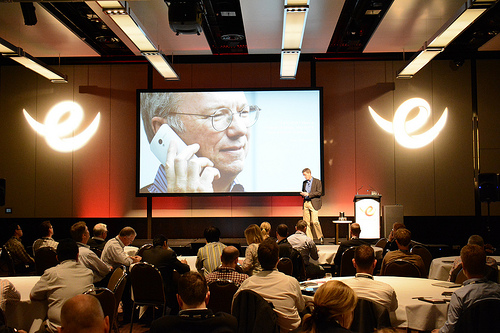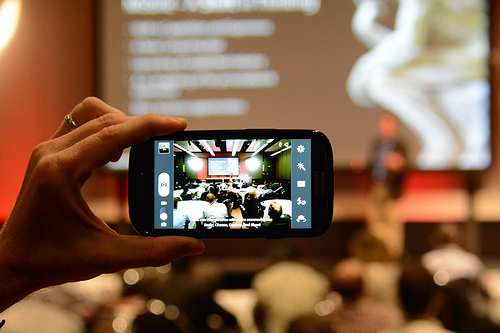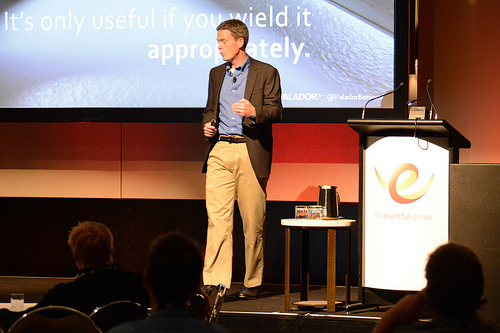Just a few shots from the Mastering Mobility conference in Melbourne Australia. It was a lot of fun to have the opportunity to deliver the opening keynote on mobile strategy. Big thanks to the folks at the Eventful Group for putting on such a great event!
Monthly Archives: September 2013
25 Things Influential People Do Better Than Anyone Else
I was honored to find that I was named as part of the Forbes article 25 Things Influential People Do Better Than Anyone Else. Check out the article and see if you agree!
Filed under Mobile, Mobile-Only
remotelyMOBILE named 2013 must read IT blog for 2nd year in a row!

For the 2nd year in a row remotelyMOBILE has been named one of the 50 must read IT blogs by Biztech Magazine.
I am honored to share the list with such other great blogs as:
- A Screw’s Loose – Brian Katz
- Sepharim Group – Bob Egan
- Chief Mobility Officer – Visage
- Mobile Edge – Galen Gruman
- Data Center Pulse – Mark Thiele
- Rob Tiffany – Mobile Strategist
Thanks to everyone who voted! Check out the full list here.
Mobile Has to Matter
This article was originally published on Sept 3 2011 on HP’s September issue of Discover Performance
Mobile influencer Benjamin Robbins describes how enterprises can approach mobility to improve the enterprise, revitalize IT, and, most importantly, serve the user. There isn’t an enterprise on the planet today that doesn’t recognize the value of mobility—not just to customers but also to employees. But mobile has emerged as such an important way of transacting business that some organizations get psyched out when they try to define their approach it. We spoke with Benjamin Robbins, co-founder of enterprise mobility consultancy Palador, on how enterprises should think about mobile and the role that IT leadership can play in a self-service world of cloud and automation. Perhaps surprisingly, he said that, in some ways, mobile is no big deal.
Q: How do most enterprises view mobile? How does that contrast with how they should view mobile?
Benjamin Robbins: Companies should not look at mobile as a separate, siloed piece of technology. Mobile should, at its core, support the company’s objectives. Companies don’t have a laptop strategy or a PC strategy. Mobile is no different—it’s just a technology that needs to support the business. The way to avoid that is to always ask why. Why are we doing this? How does it support whatever aspect of the business we want to support? How does it help move us forward?
Q: Why do most enterprises have a hard time seeing mobile as just another tool in the toolbox?
BR: People get excited and think of it as special because anytime, anywhere connectivity to apps and services is a different compute paradigm. When you’re at a client site, you used to say, “I can send you that file when I get back to the office.” But mobile shortens the cycle. Whenever there’s a need, the ability to execute is much shorter. That’s exciting for organizations, but they have to stick to the core mission and ensure that mobility supports those core business processes.
Q: Where are enterprises messing up mobility?
BR: They’re tripping up in a few areas. First, there’s the traditional way of doing IT that has a really PC-centric sense of things like security and network. But now you have people bringing their own devices to work, and IT doesn’t always want to make the shift to handle it. Second, employees can now be their own IT. Everybody doesn’t have to have the same app—maybe you like QuickOffice, maybe I like something else—and IT doesn’t intuitively know how to handle that. Third, the whole idea of “network” is changing. Network used to be a physically bounded thing you had to plug into. All of that is changing, and organizations are tripping up because the mentality of IT isn’t changing.
Q: That seems like an issue for IT leadership.
BR: Yes, I think enterprises need to get to a place where IT leadership understands that IT’s role is changing but it’s not being eliminated. Business units have the knowledge and budget to drive services they need. However, they lack the technical heft. IT’s role is to enable those services, guide those services, understand existing capabilities in the marketplace, and play a support role in implementation. Business units don’t normally have the expertise to manage those things long term, so they need a partnership with IT. You really need IT leaders who don’t view their primary job function as cost cutting. It’s got to be about enabling people, not saving money.
Q: How does a visionary IT leader get the CIO and CFO to agree that cutting costs, or languishing with flat budgets, is not the way to manage IT?
BR: It is very simple. It involves the right attitude combined with the right metrics. First, organizations need a CIO and CFO who understand that there is a shift taking place, where technology is first being approached as an operational expense rather than a capital expense. Businesses need to exit the business of owning technology and spend the cycles instead on figuring out how services will advance the core business. This eliminates the attitude of treating technology as just another utility to be managed, like electricity or garbage. Second, as with any technical project, the “why” must be tied to ROI. CIOs should be able to answer how any project, be it mobile or not, advances the mission of the organization, and what sort of metrics are being used to measure the success of the investment. Mobile in no way should eliminate the need for fiduciary responsibility. The CIO should have no trouble drawing a line between technical budgets and organizational need.
Q: What kind of expertise will IT bring to the table, now that the business can generally help itself to the services it needs?
BR: The BUs get really excited about something, but might not see the bigger picture. One BU might get super-excited about a service and dump a bunch of data into it, and use it for a year before realizing it’s not what they need. Then they have to get that data out and don’t know how. IT can help with that—and help prevent that from happening in the first place. Plus, you need people who can go deep into the data. Data streams are at the core of business value, so it’s imperative to have people who can manipulate and manage data beyond an Excel level of expertise.
Q: You spent a full year working only on a mobile device. What were the biggest insights you gleaned that might be helpful to enterprises working on a mobile strategy?
BR: I think that organizations, as part of their mobile policy, should advocate that it’s really important to maintain a healthy connected balance. If you say “we don’t need mobile,” you’ll fail, because competition will fly by you and you won’t know what happened. But by the same token, if you expect people to be connected 24/7, you’ll burn people out, and the organization will suffer, too. If you send someone an email, does it really matter that they get back to you in two minutes vs. two hours? The important thing about mobile isn’t making people use it all the time—it’s using it in the right instances. Here’s an example. There’s a medical device company and their sales team had to get in front of surgeons. They found that with mobile devices, they could get right in front of surgeons while they’re scrubbing up for the next surgery. You couldn’t do that with computers, but with a tablet you can do that. A mobile strategy shouldn’t be about being constantly connected; it should be about using the technology in the right way at the right time.
Get more from Benjamin Robbins on Twitter at @PaladorBenjamin and at Palador.com.
Enterprise Mobility is No Game
EA games (Electronic Arts, Inc.) recently released Plants vs. Zombies 2. Plants vs. Zombies has to be one of my favorite games to play on my mobile device. For those of you that don’t know, Plants vs Zombies is what’s known as a tower defense game. The object is to eliminate enemies as they attempt to cross a map. This is done by strategically placing artillery, mines, walls, etc. in the path of the approaching enemy. In the case of Plants vs. Zombies, instead of artillery, players place objects like pea-shooting plants to defeat zombies as they try to reach your house and eat your brains.
This follow-up to the extremely popular first version achieved over 16 million downloads in less than a week. However, there is one catch—it’s only available on iOS. For those of us on the Android platform, which by the way has almost 80% of the global mobile market share, we are out of luck. And with no Android release date in sight, non-iOS users are left in the lurch (bad zombie pun intended).
There are definitely financial reasons for this approach with consumer apps. For example, iOS users spend more money on apps and in-app purchases. Also, many organizations are allowing consumerization practices to influence business methodology and decision making. However, this single OS approach to app development should, categorically, not be followed by the enterprise.
Enterprise app development must take a very broad device approach. In the world of Bring Your Own Device (BYOD) there is no guarantee what devices employees will show up to work with. In order to achieve the most return on your mobile investment you should aim to support the most number of users. The allure of the simplicity and controlled nature of devices’ homogeneity is a limited strategic approach. The popular device of today will be replaced by the next cool device of tomorrow. This will lead to a never-ending cycle of playing catch-up that will be cost prohibitive.
Enterprises need to anticipate supporting the vast array of ever-changing devices on the market. Combine BYOD with the notion of the Internet of Things, and enterprises have even stronger justification for a diverse mobile approach. Anything short of a heterogeneous approach to mobile devices, apps, data, and management will paint your mobile strategy into a digital corner where you will be stuck waiting for the paint to dry.
When it comes to mobile app development, how can businesses overcome and address an ever-expanding ecosystem of device proliferation? There are platforms available for developers that do a decent job of bridging the gap between the different mobile operating systems. Platforms such as PhoneGap, Appcelerator, and Sencha allow developers to write the application in a single language that then compiles to a native app. There are some drawbacks to this approach. As much as we love the development process to be write once, use many times, cross-platform development tools still require some tweaking per OS. However, these platforms will get you 95% of the way there.
Your device management strategy needs to be heterogeneous as well. While Samsung and the upcoming iOS 7 release will offer device management and enterprise services, a single platform approach to managing devices is a step in the wrong direction. This convenience of built-in services that are vendor-based is greatly outweighed by the need to have an enterprise mobility management strategy that is flexible for the future. Organizations would be better served to explore one of the many mobile management solutions available to support a wide variety of devices, have app management, and ultimately provide information management.
As hardware diversity increases, organizations need to not only display data on various devices, but also collect data from an ever-increasing range of devices. This could include IT infrastructure, manufacturing equipment, and even display cases. The cost of embedding Internet connectivity is approaching negligible. With this hurdle removed, the matrix of connected devices in an organization is only going to grow. Is your organization prepared for this sort of dynamic addition of mobility? Are you thinking A to Z or just Apple and Android?
The consumerization of IT does not have to mean that the enterprise takes every aspect of the consumer approach and translates it directly into a business strategy. Enterprises that approach BYOD as BY-iOS-D will find they have a left-out and frustrated user base alongside an inferior position for the future. Like tower defense games such as Plants vs. Zombies, organizations need a broad heterogeneous strategy to anticipate and manage the onslaught of mobility. The inability to predict new devices and methods of connectivity necessitates this approach. There is and will be no single dominant mobile end point. Why play like there is?
Benjamin Robbins is a co-founder at Palador, a mobile consultancy located in Seattle, WA. He can be followed on Twitter @PaladorBenjamin.
Keynoting at Mastering SAP for Mobility in Melbourne Australia
I am excited to announce that I will be delivering the opening keynote, Monetizing Mobile – Mobile Strategy and Beyond, at the Mastering SAP for Mobility conference in Melbourne, Australia September 19th 2013. Mastering SAP for Mobility features an international lineup of exciting speakers and mobile influencers discussing some of the most requested and challenging mobile topics of today. In addition to the opening keynote I will be leading one of the track sessions on the mobile app development cycle.
Check out the full agenda and register today to not miss out on this opportunity to hear from leaders in enterprise mobility as well as learn how to fully leverage mobility in your organization.
Here are the hot topics the conference will cover:
Creating the Mobility Strategy – the Business Case, the Project & Technology
Hear case studies of companies who have demonstrated cost comparison vs. cost benefitsUndertake a benefi t analysis – evaluating mobility as an investmentQuantifying the benefits and how it can be measured in dollarsTips and tricks to build a solid business case for investment into a Mobility strategyEnsure your mobility solutions fit into the Business & IT PlansConstantly align the business drivers with the solution – ensuring “Mobility drives business change”Implementing the best structures to drive the projectHear tried and tested approaches from successful companies already down the trackInvolving the projects, business roles and technology in the overall strategyEvaluate native, hybrid and HTML5 – what are their merits in meeting your business requirements?Hear from those who have chosen their vendors and consultants – how they evaluated their decision
SAP Mobility & the Road Map
Understanding what SAP offers in the mobile space. How has the acquisition of Sybase and Syclo affected this and what is the roadmap for the future?What is SAP’s recommended deployment path and the costs and efforts involvedStandardised mobile asapps – what apps? What capability? What quality? Consumers used to a level of quality and interactivity, native vs. webThe development tools which are neededMaintenance across the SAP mobility landscape.
Effective Change Mgmt Strategies, Training & Support
Selling the system and gaining commitment and alignmentManagement buy-in generating top-down driveOvercoming fear of the system in the workforceBringing the business and IT closer together through an initiative that both are passionate aboutHow to handle changing a workforce that don’t (won’t) use smartphonesWho should support your mobility initiative, what skills are needed and how do you find them?Build a strategy to cope with the skills requirements and how to acquire themManaging the rapid training requirements of the changing technologySurviving the changing workforce issues of 24/7 availability and work/life balanceHow to support your mobility initiative, building the skills needed
Designing Your Native, Hybrid & HTML5 Mobile Apps
Understand which style of app makes sense for your organisation, the business case and your cheque bookEvaluating the various styles to build and develop a coherent mobile strategyEmbracing open source mobile technologiesHow SAP supports HTML5 frameworks like Sencha, Appcelerator and PhonegapBuilding into your team the skill sets necessary to produce and support these approaches
Integration
Use SAP tools (SUP, Syclo, NetWeaver Gateway), 3rd party tools or custom developed tools for middleware between mobile application and back-end systemsOvercoming potential performance issues caused by having mobile apps talking to the back-end systemDealing with data synchronisation issues with modifications in the back-end system and by mobile applicationHow you integrate SAP mobile solutions with NFC/M2M/GIS technologiesHow to handle security of internal systems being accessed by external mobile applications
Security Management
Creating a robust security strategy, inclusive of safety, HR and privacy policies and connectivity issuesThe approaches for securing data and authenticating usersEnabling single sign on approvals across multiple appsReal examples from organisations who have overcome very sensitive information issuesConnecting back to your corporate network – the security layer you implement and still have ease of access
Communications Infrastructure & Device Management
An overview from case studies on the infrastructure hardware/software requiredUnderstanding what the investment in infrastructure could be – pricing and licensingManage the impact of the platform performance on device response/performanceExamining SAP offerings vs. partner offeringsThe impact of the Cloud
Device Selection & Management
Device management – which tools are available – what you need to know about device compatibilityChoosing the right device(s) for corporate rolloutDevice Management software – hear what’s out there such as SAP Afaria (Sybase) and alternativesChange control for device software – change control applicationsManaging the issues around BYOD – what other companies have chosenSecurity issues arising from BYOD policies
Mobile Business Intelligence
Defining the value and purpose of mobile BI in the workplaceDeliver mobile experiences on SAP BW from simple no frill models to comprehensive mobile strategiesUnderstand the generic components of a mobile solutionSAP and 3rd party mobile BI technologiesExamining native, cross-platform native, hybrid and HTML5 application frameworks
Filed under Uncategorized








